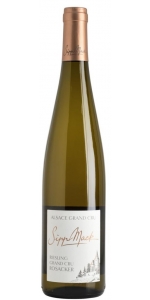Wine from Sipp Mack

An exceptional environment
The vineyards surrounding Hunawihr whisper the timeless story of the village’s cherished bond with the world of wine. As you wind your way up the picturesque, narrow streets, you can appreciate the Alsace traditions passed down over the centuries as they seep from the timber-framed, geranium-bedecked homes.
Nestled at the top of the village, you will find Sipp Mack, a 9th generation family winery, currently run by Laura and Jacques Sipp with their daughter, Carolyn.
Generational winemaking relays
The Sipp Mack winery was created in 1959 following the marriage of two winemaking families, François Sipp from Ribeauvillé and Marie Louise Mack from Hunawihr. In 1983, following his viticulture and enology studies, business school and work experiences in American wineries for 2 years, their son, Jacques, returned to Alsace to join the family estate. He brought his wife, Laura, a Californian graduate from the University of California Davis wine program, back with him.
Jacques and Laura brought new vision to the vineyard and winery operations. Their desire to make consistently high quality, pure wines that reflect their soils led them to combine Alsatian traditions with modern technology and production methods that protect the environment. After years certified sustainable farming and integrated pest management, they converted the entire domain to certified organic farming.
Today, a new breeze flows through the family winery with the arrival of their daughter, Carolyn. Her dynamism and creative ideas enrich and consolidate the domain’s artisanal viticulture and winemaking approach.
Rooted in history yet open to the future, each generation brings initiatives and encouragement to the preceding generation while nourishing each other with their experience.
A modern vision
By recognizing the value of team work among their staff, they strive to create a fulfilling and dynamic work atmosphere.
Not surprisingly, Sipp Mack has evolved over the years. Fifty percent of the wines produced are now available in several export markets. In spite of the relatively rapid changes, the estate has managed to keep its family-oriented nature and its appreciation of its rich heritage. Locals, wine amateurs from near and far, and tourists looking for “the road less traveled” enjoy sharing conversations (often multilingual!) around the tasting room table, surrounded by beautiful artifacts from the past nine generations.
GRAND CRU ROSACKER – HUNAWIHR
Named after the wild roses growing along its border, the Grand Cru Rosacker vineyards extend to the north of Hunawihr over a surface of 26.18 Ha (64.7 acre). The vineyards face east-south-east at an altitude between 260 and 330m. The soil, a heavy, grey limestone with intertwined layers of marl (calcareous clay), is very rich in calcium and magnesium.
Sipp Mack cultivates 2.10 Ha (5.2 acre) of Riesling Grand Cru Rosacker.
Young, the Riesling Rosacker has a racy, firm temperament with a sharp, peppery aroma that mellows with age. The wines reveal full strength over time, expanding in depth, unveiling complex, yet subtle mineral flavors, which are characteristic of Rieslings from great terroirs.
GRAND CRU OSTERBERG – RIBEAUVILLÉ
The Grand Cru Osterberg vineyards are located on the steep, sun-drenched, east-south-eastern slopes of Ribeauvillé at an altitude between 250 and 350 meters. They cover 24.60 Ha (60.8 acre) and have stony, clay-over-marl soils.
Sipp Mack’s Grand Cru Osterberg fields, around 0.84 Ha (2.1 acre), are planted in Riesling and Pinot Gris.
The Riesling Osterberg is opulent, and a touch sweeter and richer than the Grand Cru Riesling Rosacker. With age, it develops a strong body, a wonderfully subtle aroma, and an outstanding mineral character. It is a perfect wine for aging.
The Pinot Gris Osterberg is complex and powerful, with rich fruit sweetness. This richness is perfectly balanced with a good acidity, giving the wine elegance and finesse. The Pinot Gris Osterberg also may be kept for 10 years before drinking.
Domaine Sipp Mack Alsace Pinot Gris Grand Cru Rosacker is made from 100 percent Grand Cru Pinot Gris.
Rigor and diligence were the key words for this emotional 2016 vintage!
The year starts with heavy rainfall and low temperatures, severely delaying the growing cycle. The month of May sees temperatures increase and the tropical atmosphere favors the development of mildew. Finally, the dry and sunny summer allowed our heavy soils to avoid maturity blockages linked to water stress. The 2016 harvest started in early September and ended 7 weeks later, a record!
In the cellar, the sanitary condition was very good, the wines developed freshness, complexity and fine, ripe acidity.
SITUATION
Fresh notes of mango and peach, enhanced by a sweet sensation, dominate the palate. The finish is long thanks to a lively acidity. It will go perfectly with white meats, firm fish and cheeses with character.
Review:
Ripe, pristine notes of yellow pear on this wine's nose come with notions of creamy banana and vanilla. The palate carries rich, concentrated fruit, but in a precise fashion that channels the rounded ripeness into smooth generosity. A vein of freshness and smidge of sweetness give the fruit staying power and verve. Together they present an off-dry wine with immense potential and elegance. Drink by 2045.
-Wine Enthusiast 94 Points
- back
Selected Options
Wineries
Categories
Pricing
Countries
Regions
Grape Types
Wineries
Organic/Free Shipping
This wine is floral, exuberant, with lengthy smooth tannins, and metallic notes.
This cuvée takes its name from a small parcel of the Adrianna Vineyard that is completely covered with oval white stones and was the site of an ancient riverbed. The abundant stones provide optimal drainage and extreme temperatures. They absorb heat and moderate the nights, but also function like ice cubes after a very cold night. Stony soil Malbecs tend to be extremely aromatic, rich and luxurious, just like the River Malbec from Adrianna. This wine can be enjoyed young or aged for decades.
Pair with grilled meats.
Review:
There is an usual stony austerity in the 2021 Adrianna Vineyard River, cropped from a cold year when the full clusters fermented in concrete with a slightly shorter maceration and an élevage in a 2,000-liter oak foudre and the rest in stainless steel. It has a moderate 13.4% alcohol with very high acidity (8.2!) and a low pH (3.37), incredible parameters of freshness. The wine was closed and took time to take off in the glass, revealing a very elegant and subtle personality, with the silky texture of the very fine tannins, pristine aromas and flavors and a sense of harmony that was moving. It's powerful but extremely elegant in that rare combination of clout and energy, a wine of light, aerial, with some ethereal qualities, delicate and refined. This combines the cool place and high altitude, the cool year and the stony soils, to deliver a stunning Malbec that goes well beyond the variety. Bravo!
-Wine Advocate 100 Points
Ferrata Punta Drago Etna Rosso is made from 100% Nerello Mascalese.
Pale ruby red color, elegant bouquet of red berries, spicy notes and underbrush. Great structure, silky tannins, soft and elegant.
Suitable with hors d'oeuvres of cured meats, aged cheese, meat dishes but also fish recipes.





